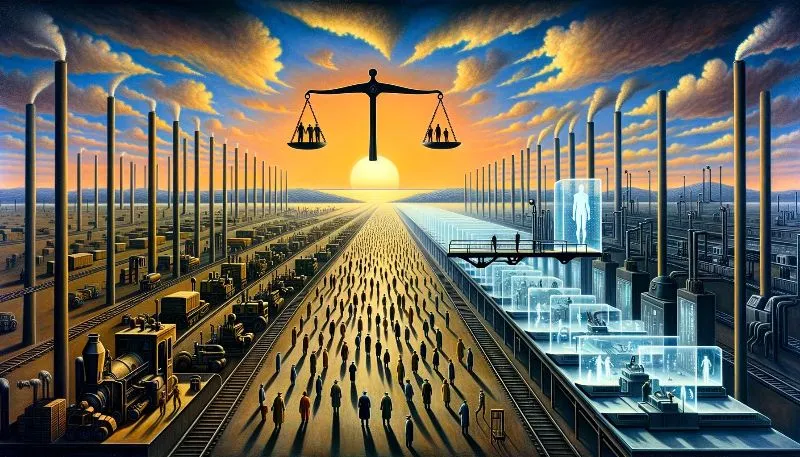The dawn of automation has ushered in a new era of technological prowess, reshaping industries and redefining the nature of work. As machines, powered by advanced algorithms and artificial intelligence, take on roles from manufacturing to customer service, the fabric of the workforce undergoes a transformation. This shift, while heralding unparalleled efficiency and innovation, also brings to the forefront complex challenges.
The immediate allure of automation lies in its promise: streamlined operations, reduced human error, and the potential for exponential growth. Industries can produce more, faster, and with greater precision. Yet, beneath this allure lies a more intricate narrative. For every machine that assumes a role, there’s a human worker facing uncertainty. The bank teller replaced by an ATM, the assembly line worker by a robot, and the list goes on.
This displacement raises critical questions about the future of labor rights. How do we ensure economic security for those whose jobs are automated? What policies can bridge the gap between old roles and new opportunities? And, at the heart of it all, how do we uphold human dignity in a world where machines are increasingly intertwined with our daily lives? As we navigate this uncharted territory, the balance between embracing technological advancement and safeguarding human rights becomes paramount.
The Transformative Power of Automation
Beyond the confines of factories and data centers, automation’s influence permeates various sectors, reshaping operations and consumer experiences alike. Its transformative power is evident not just in the tasks it assumes but also in the broader changes it instigates within industries.
Take the healthcare sector as an example. Automation has introduced telemedicine platforms, allowing patients to consult doctors without physical appointments. This not only streamlines medical consultations but also makes healthcare more accessible to those in remote areas. Similarly, automated diagnostic tools can now analyze patient data, offering preliminary diagnoses faster than traditional methods.
In the realm of retail, automation has redefined shopping experiences. Self-checkout kiosks in supermarkets reduce waiting times for customers. Online shopping algorithms suggest products based on user behavior, enhancing personalized shopping experiences. These changes don’t just offer convenience; they also necessitate a shift in the skill sets employees in the retail sector need, emphasizing digital literacy and customer service in a virtual setting.
The travel and tourism industry also feels automation’s impact. Automated booking systems, virtual tours, and AI-driven travel suggestions have transformed how we plan and experience vacations. This shift means travel agencies now focus more on curating unique experiences rather than just booking logistics.
In education, automated administrative systems ease enrollment processes, and AI-driven platforms offer personalized learning paths for students. Teachers can now focus more on mentorship and addressing individual student needs, as automation handles repetitive administrative tasks.
The Human Cost of Progress
The ripple effects of automation extend far beyond the confines of industries and into the very lives of those it impacts. As machines and algorithms assume roles once held by humans, the repercussions are felt deeply on a personal level.
Imagine the seasoned bank teller, who, after years of service, finds their role redundant due to the efficiency of ATMs. Or the factory worker, skilled in assembling products, only to see robots perform the same task with greater speed. While technology advances, the human element faces a period of adjustment and, in many cases, displacement.
As we herald the benefits of automation, it’s crucial to address its human cost.
For some, this transition might open doors to new opportunities, perhaps in overseeing the very technology that replaced them. They might undergo training, adapt to new roles, and continue their professional journey. However, not everyone navigates this change seamlessly. Many face the daunting reality of unemployment, grappling with financial instability and a shaken sense of self-worth.
This displacement transcends mere economic concerns. It delves into the realm of human rights. Employment isn’t just about earning a wage; it’s intrinsically tied to one’s sense of purpose, identity, and place in society. Being gainfully employed affords individuals not just financial security but also a sense of contribution and purpose.
As we herald the benefits of automation, it’s crucial to address its human cost. Societies must ensure that progress doesn’t come at the expense of the very people it aims to benefit. Labor policies, retraining programs, and support systems must be in place, ensuring that every individual’s right to dignity, purpose, and a fair chance at employment remains uncompromised.
Training: The Bridge to the Future
As we stand at the precipice of an automated era, proactive measures become essential. The wave of automation, while bringing efficiency, also ushers in the need for a workforce evolution. The key to navigating this change lies in training and reskilling.
Consider the realm of customer service. With chatbots handling initial queries, human agents must now specialize in handling more complex issues, requiring deeper product knowledge and problem-solving skills. Similarly, as AI tools analyze data in sectors like finance, employees must pivot to roles that interpret and strategize based on AI’s findings.
Stakeholders, from policymakers to industry leaders, must come together to shape labor policies that champion both technological progress and human well-being.
Governments and industries have a pivotal role to play here. Establishing training programs tailored to emerging technological trends can bridge the gap between current skills and future needs. For instance, a factory worker displaced by robotics might undergo training in robot maintenance, turning a challenge into an opportunity.
Moreover, educational institutions can integrate future-ready curricula, emphasizing digital literacy, data interpretation, and other skills paramount in an automated landscape. Collaboration between industries and educational bodies can ensure curricula remain relevant and dynamic.
Ethical Implications: The Need for Fairness
The march of automation, while promising a brighter, more efficient future, also casts shadows of ethical dilemmas. The crux of these dilemmas lies in the distribution of benefits and the potential for disparities.
Imagine a scenario where a company, having integrated automation, sees a surge in profits. While shareholders rejoice, the workers, whose roles have been minimized or replaced, face an uncertain future. If the increased profits don’t translate to better wages or retraining opportunities for these workers, the ethical foundation of such progress becomes questionable.
This scenario underscores the importance of labor policies that champion fairness. Companies benefiting from automation should be incentivized or even mandated to reinvest a portion of their gains into their workforce, be it through training programs, better wages, or job placement initiatives.
Furthermore, the broader economic landscape demands scrutiny. If automation leads to significant wealth accumulation for a select few, while the majority grapple with job loss and stagnating wages, societal rifts could deepen. Such concentration of wealth could exacerbate existing inequalities, undermining the very fabric of cohesive societies.
In navigating the automated future, a compass of ethical considerations is essential. By placing fairness at the forefront, we can chart a course where technological advancements uplift all, ensuring a balanced, inclusive, and just future.
A Global Perspective: Automation Beyond Borders
The tendrils of automation extend far and wide, transcending national boundaries and weaving a complex web of global interdependence. A single change in an industry’s automation strategy in one nation can send shockwaves through supply chains, labor markets, and economies in distant lands.
By fostering international cooperation, we can ensure that as industries evolve, the rights and well-being of workers worldwide remain a central focus.
Consider the textile industry. If a major clothing manufacturer in one country adopts automation, reducing its reliance on manual labor, the impact is multifaceted. Suppliers in other countries might feel the pressure to automate to keep up with reduced costs. Workers in these supplier nations, many of whom rely on manual labor roles, could face job insecurity.
Similarly, as automated financial tools become the norm in major economic hubs, emerging markets might grapple with the challenge of integrating with these systems or risk being left behind. Such scenarios underscore the need for cohesive, globally-minded labor policies.
To address this, international collaborations become paramount. Global forums and conventions can facilitate discussions on standardizing labor policies in the face of automation. By fostering international cooperation, we can ensure that as industries evolve, the rights and well-being of workers worldwide remain a central focus.
In this era of globalized automation, the vision must be broad, encompassing not just local industries but the larger, interconnected global ecosystem. Through collective effort and shared understanding, we can steer the course of automation towards universally beneficial outcomes.
The Road Ahead: Balancing Technology and Humanity
As we venture further into the age of automation, the interplay between technology and humanity becomes increasingly intricate. The allure of technological advancements, with their promise of efficiency and innovation, often contrasts with the very human concerns of job security, identity, and societal cohesion.
Initiatives that promote lifelong learning, adaptability, and mental well-being will be crucial.
One of the pivotal challenges lies in ensuring that as machines become more integrated into our workplaces, human values remain at the core of our strategies. It’s not merely about adopting the latest technology but about integrating it in ways that uplift and support the human spirit.
For instance, while an automated system might optimize productivity, it’s essential to ensure it doesn’t inadvertently foster a workplace culture devoid of human interaction, mentorship, and growth. Similarly, as digital platforms revolutionize sectors like education or healthcare, the human touch—be it a teacher’s encouragement or a doctor’s empathy—mustn’t be overshadowed.
Crafting such a balanced future demands collaborative efforts. Stakeholders, from policymakers to industry leaders, must come together to shape labor policies that champion both technological progress and human well-being. Initiatives that promote lifelong learning, adaptability, and mental well-being will be crucial.
This piece was crafted with insights from ChatGPT-4






